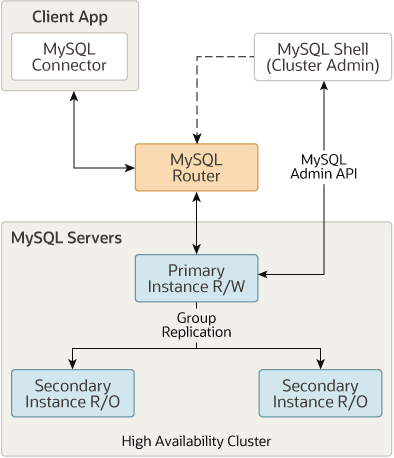MySQL Cluster Overview
In MySQL Cluster, there is typically no replication of data. It has only data node synchronization
MySQL Cluster is a shared-nothing architecture
- As a result, no two components of the cluster will share the same hardware.
- The cluster will be fully operational when at least one node is upon each data node group. As a result, the MySQL cluster avoids single point failure and ensures 99.99% availability.
Replication <--> Cluster
Replication
- Master-Slave, one server is designated to act as the master.
- (there is also master-master configuration).
- Asynchronous - not all nodes have the freshest data at all time
- No automatic failover
Cluster
- Internally, the MySQL Cluster also uses synchronous replication.
Replication | Cluster | |
|---|---|---|
Asynchronous / synchronous | Asynchronous | synchronous |
| Automatic failover | No (a slave has to be promoted to master) | Yes |
Downtime when a master fails | Yes | No |
MySQL InnoDB Cluster
MySQL InnoDB Cluster provides high-availability and scaling features.
MySQL InnoDB Cluster consists of at least three MySQL Server instances.
MySQL InnoDB Cluster usually runs in a single-primary mode, with one primary instance (read-write) and multiple secondary instances (read-only).
- Table creation and data insertion can be done only on the primary instance.
- (Advanced users can also take advantage of a multi-primary mode, where all instances are primaries. This is not the common case).
MySQL InnoDB Cluster data nodes are actually a Group Replication.
InnoDB Cluster does not provide support for MySQL NDB Cluster.
MySQL NDB Cluster
A standard MySQL server does not support the MySQL Cluster engine NDB.
- MySQL Cluster is tightly linked to the MySQL server, yet it’s a separate product.
- This means we need to install the custom SQL server packaged.
MySQL Galera Cluster
- Galera Cluster for MySQL is a true Multi-Master Cluster based on synchronous replication.
- It is a multi-master database cluster that supports synchronous replication
- https://galeracluster.com/

No comments:
Post a Comment